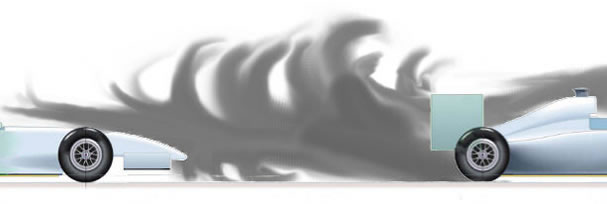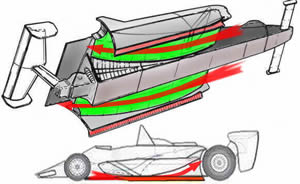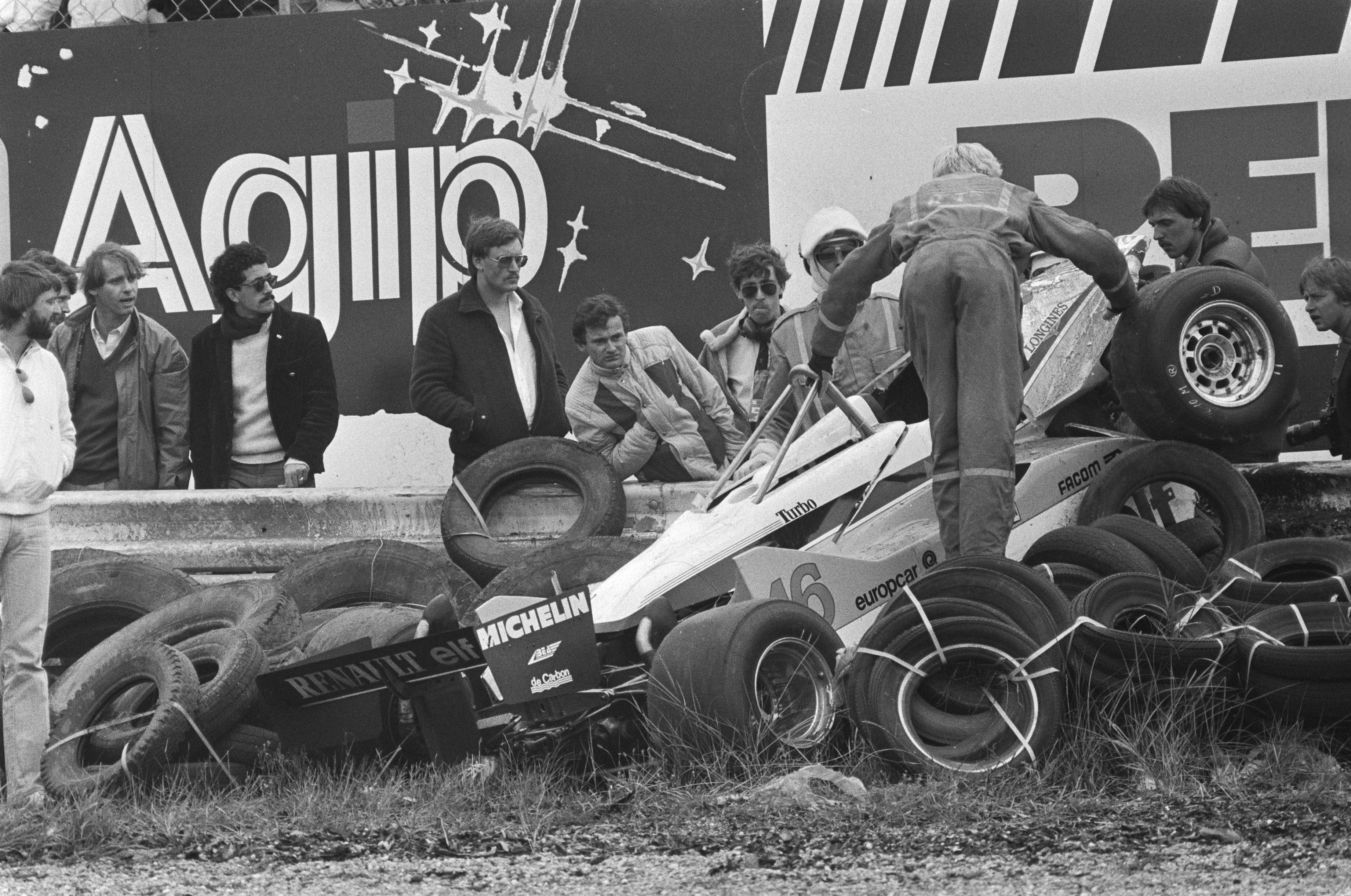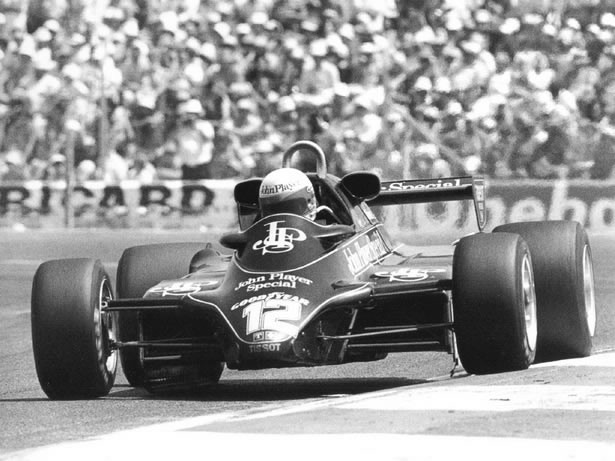 |
| Sometimes the answers can come from the past.. |
What should an F1 car be? Ask most fans and they would tell
you the fastest circuit race cars on the planet. They should have a degree of
difficulty to drive that allows talent to shine through. They must have a purity
in design and driving experience that reflects the pinnacle of motorsport. The
racing spectacle should be as entertaining as possible whilst the sport being
at the forefront of technology to keep the manufacturers involved. This balancing act and ideal vision of the
sport has become somewhat eroded. Yet look into the sports past and you will
find a technology that could re address this balance and bring the spark back
the audiences are currently longing.
 |
| Still tail happy at low speed |
What are the modern turbo F1 cars like to drive? Certainly
they are not the turbo charged monsters we saw in the 1980s era. Many including
me fantasised of ridiculously powerful cars squirming sideways and forcing the
drivers to wrestle them into submission. Even with recent rules restricting
downforce, modern cars have so much more grip than their 1980s counterparts. They
feel glued to the road and more refined compared to rocket propelled shopping
trolleys. At slow speed the back end will still squirm under the huge torque of
the turbo engine breaking traction. But throw the car into a bend at speed and
the front wing and complex rear diffuser will produce a huge amount of
downforce making the car feel stable and planted. That’s right, modern F1 although recently
dominated by engines is still all about downforce. Back
in the 1980s teams were dominated by engineers, today the design teams are
guided by aerodynamicists. HNDs have made way for Aeronautical degrees as reluctant
poster boy Adrian Newey proved with success that every aspect of the car should
be optimised for aero efficiency. Now aerodynamicists
lead the design direction of the car.
 |
| Complex modern front wings |
There is one single component on an F1 car that generates
around a third of this downforce. It is the front wing. By means of hugely
complex winglets and end plates these wings also play a vital role in channelling
air around the disruptive tyres and under the car. As rule changes evolved this
component has become the holy grail of car design. You might find your F1 nerd trying to impress by attempting to explain the latest wing upgrade that he has read in Scarb's blog or Autosport magazine. The truth is such is the complexity you truly need an Aeronautical degree to really understand the design direction of front wings. Teams plough millions into developing
them which individually cost alone around £100,000. Think of this when
Maldonado love taps his next opponent and comes into the pits for a new one.
 |
| 'Dirty Air' phenomenon |
 |
| Ground effect 'Venturi' tunnels |
If you asked an alien to design a fast single seater racer
using earth’s technology, would it have a large and highly important, expensive
and complex front wing? No and far from it. To find the most natural, simple
way of a car producing high amounts of downforce with as little cost and drag
as possible you have to go back in time to 1977. Legendary Lotus founder Colin
Chapman had been studying aerodynamics at the British jet fighter manufacturer De
Havilland. Aerodynamics had already come to importance over 10 years ago when ‘wings’
appeared on racing cars. Wings are in fact upside down aircraft wings. Instead
of producing lift the wing produces downforce, pushing the car into the ground
and producing grip and speed. Colin was further inspired by fluid dynamics and how
they worked on De Havilland’s ‘Mosquito’ fighter aircraft. He came to realise
that the underside of the car could be profiled into a curve, similar to a wing
face. Plastic brushes and later rubber around the edge of the cars floor
created ‘skirts’ which stopped air interfering with this large area of low
pressure. The ‘Venturi’ affect as it is called would basically turn the entire
car into a wing, sucking it to the ground. His ideas were relayed back to his
designers Peter Wright, Martin Ogilve, Tony Rudd and Ralph Bellamy. Penned as
the ‘Lotus 78’, a new car was born out of these ideas and principles. The front
wing was small and skinny and all that was required to address balance and
allow the underside of the car to work optimally. Sculptured after many hours in Imperial
College London’s wind tunnel, the result was in my eyes the most beautiful car
to ever grace a racing circuit.
 |
| The Lotus 79 changed motorsport forever |
Introduced for the Argentinian Grand Prix in 1977 the benefits
were obvious and the cornering speeds were phenomenal. Unfortunately the grip
was being generated so far forward in the car that a huge rear wing was
required to keep the back end in check. This meant the car suffered on the
straights with drag. This coupled with an underpowered and over worked Cosworth
DFV it wasn’t enough to top the season and the team finished the constructors
championship 2nd. Efforts went into reducing the rear wing size and
tendency to oversteer for the new much more rounded '79'. That went on to win 9 of the 15
races and won the World Championship with Mario Andretti. A successful year was marred by the death of the
talented team mate Ronnie Peterson, succumbing to injuries sustained from an
off-line pile up at the Italian Grand Prix. It would prove to be Team Lotus’
last World Championship and it wasn’t long until the rest of the field cottoned
onto the advantages of ground effect. However many teams did not have the
budget for wind tunnel testing and the results were crude applications often
with undesirable side effects. Disturbances in the airflow under the car would
cause cars to ‘porpoise’ or rock back and forth. This could often be violent
and was particularly uncomfortable for the driver as the cars had to be run on
rock hard suspension to maximise efficiency. At times the cars could lose their
ground effect and grip in an instant with scary results.
‘To be honest, there
was no such thing as cornering technique in the ground effect era. “Cornering” was a euphemism for rape practised
on the driver. . . When you came into a corner you had to hit the accelerator
as hard as you possibly could, build up speed as quickly as possible and, when
things became unstuck, bite the bullet and give it even more. In a ground
effect car, reaching the limit was synonymous with spinning out.’ – Niki Lauda
 |
| 1982 proved a dangerous season |
FISA were worried with cornering speeds and teams
experimenting with ground effect with very little aerodynamic knowledge. Skirts
could break sending cars off the track at high speeds. Patrick Depailler was
killed testing for the German Grand Prix in 1980. While the accident was blamed
on suspension failure and poor guard rails the car was travelling at
significant velocity at the high speed Ostkurve, thanks to ground effect. The
following year skirts were banned by FISA but teams had other ideas such was
the advantage. Skirts that dropped out on circuit but retracted to hide from scrutineering
were developed and FISA lifted the ban in 1982. Cars continued to have
accidents at very high speeds with legend Gilles Villeneuve losing his life at
Zolder in Belgium. Although not the cause of Villeneuve’s death, again the high
speed of the cars played a factor. Turbo engines were beginning to appear in F1
and were looking to make a scary combination. Villeneuve’s team mate Didier Pironi
suffered a horrific crash at the German Grand Prix were the ground effect of
the cars in front had thrown up a fog like mist from the wet race track.
Unsighted Pironi smashed into the back of Alain Prost’s Renault severely
injuring his legs, surviving but ending his career. Across the pond Gordon Smiley lost his life in an horrific high speed accident in his ground effect car at the Indy 500. FISA had enough and made a
flat under tray under cars which effectively banned ground effect from Formula
One. While it continued
Today in principle we still have ground effect but at a very
restricted level, with the diffuser at the rear of the car. Bring back unrestricted
ground effect with today’s understanding of aerodymanics would result in the
drivers having to wear G suits – the cornering speeds would be ridiculous and
highly dangerous. However remove the complex over body aerodynamics and the over
reliance on the front wing and you have the potential for some great racing.
Limitations, be it on tyre compound and some clever restrictions on the ground
affect area would bring the cornering speeds down to acceptable levels. This
wouldn’t be the highly explosive twitchy cars of old. Ground effect can now be
applied with modern safety standards. The band aid of DRS would be redundant
and even road cars would benefit from the most efficient way of producing grip in
this age of efficiency.
Now it looks like the F1 circus is starting to see sense, with
proposals for ground affect for 2017 up for discussion by the Strategy
Group. Jenson Button supports the
notion, “if you’re going to work with downforce it should come from the floor
rather than the wings, because you can race closer and fight, and you don’t
have as much dirty air from the wings for the car following,”
Let’s hope the proposal makes some serious inroads. In 2012
the idea of ground affect was thrown out the window with teams stating their
worry over costs. The reality was the dominant and powerful teams in the sport
at the time, namely Redbull and Ferrari, didn’t want the pecking order shaken
up by a fundamental redesign. You can be ensured after this initial investment
the costs of development would be slashed . Bring it back I say…
 |
| Elio De Angelis at the French Grand Prix 1982 |

